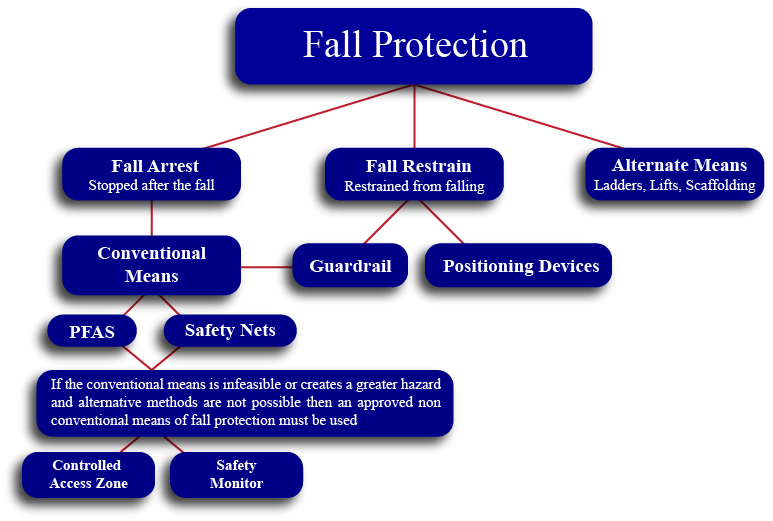Fall Protection Safety Rules
Falls from elevation are a major cause of injuries and deaths in the construction industry. Unfortunately, almost all sites, at some point during construction, have unprotected sides and edges, wall openings, or floor holes. If these sides and openings are not protected, injuries from falls or falling objects may result. All contractors should be committed to eliminating these injuries caused by instituting a 100% fall protection program, with target heights beginning at:
• Six (6) feet or greater on buildings (Subpart “M”),
• Ten (10) feet of greater on Scaffolding (Subpart “L”),
• Twenty-four (24) feet or greater on fixed ladders (Subpart “X”),
• Portable Ladders, no fall protection required (Subpart “X”),
• Beginning at fifteen (15) feet in steel erection (Subpart “R”), and
• Four (4) during maintenance operations (29 CFR 1910)

By protecting floor and roof opening (cover or guardrail) and using one of the conventional means of fall protection (Guardrails, Personal Fall Arrest System (PFAS) or Safety Nets) no fall protection plan is necessary. However, on all work sites where the contractor can prove that the conventional means of fall protection is infeasible or creates a greater hazard; the contractor will have to submit in writing and obtain the approval from the controlling contractor accepting a site-specific fall protection plan before any employees begin work. The employees on that specific job will have to be trained on the fall hazard recognition, the method and techniques used to implement fall protection and the special protocols of the site-specific plan. It must be clear that employees who fail to follow this policy are subject to disciplinary action, up to and including dismissal.
Although the Fall Protection Standard does not mention them, OSHA does accept properly utilized fall restraint systems in lieu of fall arrest systems when the restraint system is rigged in such a way that the employee cannot get to the fall hazard. This would be similar to keeping a short lead on your dog… the dog can reach the edge of the road, but the lead is too short to allow the dog to get in the road however it could get run over. In construction the lead is long enough to do the work, but not long enough to fall.
The evaluation of the jobsite and the completion of the fall protection work plan will be done by a designated “Competent Person”, who has an understanding of OSHA’s fall protection requirements, the fall protection systems available for use, and has the authority to take corrective action to eliminate employee exposure to fall hazards.

Fall protection will be provided either through the use of the conventional means of fall protection, an alternative means of fall protection or a fall restraint system. The choice will be made by the “Competent Person” and will depend on the job to be done, the site-specific circumstances, the equipment available and the knowledge of the people in the field. In many cases more than one means of fall protection will be used. As the job changes the field operation may have more or fewer choice to protect the people in field. Always consider the means that will provide the best protection for the employee, not the quickest or cheapest fix.
The following flow chart will exemplify the means available to the “Competent Person” to achieve a means of fall protection for the employees exposed to fall hazards.

All employees should receive basic safety training along with job specific training for the tasks they are to perform. U.S Safety provides all kind of courses to capacitance employees to help them avoid accidents and be safe while they are performing their job. Our goal is to have everyone go home in the same condition they came to work.
U.S. Safety provides training for all levels of employment, we have 4 types of Fall Protection courses, such as:
• Competent Person Fall Protection
• Fall Protection Supervision
• Fall Protection User
• Fall Protection Awareness

